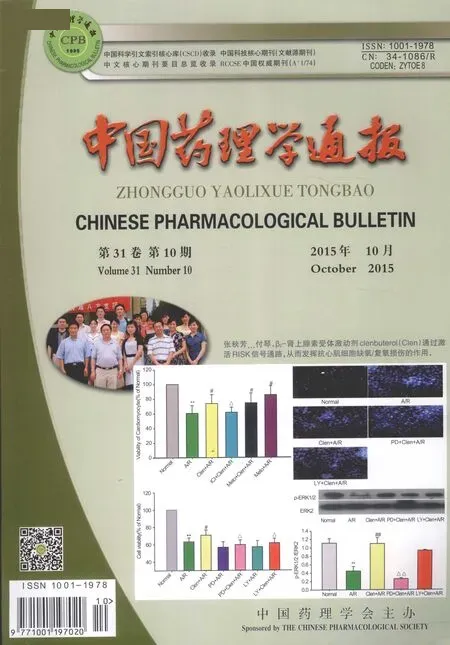E-钙粘蛋白异常表达与支气管哮喘研究进展
陶 羽,刘兆国,季 律,王 燕,王晓钰,包凯帆,王 璨,于 曦,刘海亮,洪 敏,2,江国荣,3
(1.南京中医药大学药学院,江苏南京 210023;2.江苏省中药药效与安全性评价重点实验室,江苏南京 210023;3.南京中医药大学附属苏州市中医医院苏州市吴门医派研究院,江苏苏州 215003)
E-钙粘蛋白异常表达与支气管哮喘研究进展
陶 羽1,刘兆国1,季 律1,王 燕1,王晓钰1,包凯帆1,王 璨1,于 曦1,刘海亮1,洪 敏1,2,江国荣1,3
(1.南京中医药大学药学院,江苏南京 210023;2.江苏省中药药效与安全性评价重点实验室,江苏南京 210023;3.南京中医药大学附属苏州市中医医院苏州市吴门医派研究院,江苏苏州 215003)
中国图书分类号:R-05;R341;R562.250.22;R977.6
摘要:支气管哮喘是一种严重影响人们生活质量的呼吸系统疾病,多种因素介导该病的发生与发展,其中尤以E-钙粘蛋白(E-cadherin,E-cad)的异常表达最为关键。研究发现,E-cad是一种重要的细胞黏附分子,其主要功能在于维持细胞之间的结构完整性以及参与改善气道的重塑和免疫功能的修复。进一步研究表明,支气管哮喘患者的气道上皮细胞其粘膜屏障功能常常遭受破坏,且黏膜分子E-cad的表达明显降低,这表明E-cad的异常表达参与了支气管哮喘的发生。该文对近年来E-cad的异常表达与支气管哮喘研究进展进行综述,重点对E-cad异常表达介导支气管哮喘发生发展的分子机制进行概述,并对靶向E-cad治疗支气管哮喘的策略进行探讨,为临床的后续研究和治疗提供参考。
关键词:E-钙粘蛋白;支气管哮喘;气道上皮细胞;黏附分子;异常表达;分子机制
网络出版时间:2015-9-14 14:53 网络出版地址:http://www.cnki.net/kcms/detail/34.1086.R.20150914.1453.002.html
支气管哮喘(简称哮喘)是一种由多种炎性细胞及组分参与的慢性炎症性疾病[1],严重威胁人们的生活质量。已有研究发现多种蛋白参与了支气管哮喘的发生与发展,其中尤以E-钙粘蛋白(E-cadherin,E-cad)的作用最为明显。E-cad是一类同源细胞间黏附的钙离子依赖性跨膜糖蛋白,它不仅介导蛋白与蛋白之间的相互作用,同时对于维持上皮细胞形态、组织完整及气道重塑发挥重要作用[2]。诸多研究表明,E-cad的异常表达与多种炎症密切相关,如胆管炎[3]、膀胱炎[4]及慢性牙周炎[5]等,且进一步研究发现,E-cad在这些炎症中的表达均呈现下调趋势。近年来,有研究发现E-cad在哮喘患者尤其是支气管哮喘中的表达明显降低[6-8],表明E-cad在支气管哮喘的发生发展过程中发挥了重要作用。本文对近年来E-cad在支气管哮喘中作用研究进展进行综述,并对E-cad异常表达介导支气管哮喘发生与发展的分子机制进行概述,为后续研究及临床治疗提供重要参考。
1 E-钙粘蛋白及其主要生理功能
E-cad是一种I型跨膜糖蛋白,分子质量约120 ku,定位于人染色体16q22.1区域,广泛分布于上皮细胞表面,能够介导黏附连接蛋白(Adherens Junctions,AJs)连接相邻的细胞并使细胞-细胞间的连接成熟。研究发现,E-cad是由一个上皮细胞间同型的、钙离子依赖黏着的胞外域和一个高度保守的胞质尾组成[9]。在细胞膜上,E-cad的胞质区域只有和锚蛋白P120 catenin、β-catenin以及α-catenin结合,进而与微管网和肌动蛋白细胞骨架形成接口,从而使得其处于结构上的稳定状态。E-cad除了能维持细胞的正常结构,还能通过紧密连接蛋白(Zonula Occludens 1,ZO-1)及相关核酸结合蛋白等多种转录因子调节细胞的增殖和分化[10]。与此同时,研究还发现E-cad还能够为紧密连接蛋白(Tight Junc-tions,TJs)等连接复合物的形成提供必要的结构。研究显示,当支气管上皮层中的E-cad异常表达时,会引起TJs的组成蛋白ZO-1、occludin及claudins发生异位,进而导致TJs结构发生扭曲[11]。该研究表明,气道上皮细胞中E-cad在建立和维持细胞-细胞间的连接中起到不可或缺的作用。
2 E-钙粘蛋白异常表达介导支气管哮喘的发生与发展
研究发现,哮喘患者中分化的支气管细胞连接分子E-cad和ZO-1的表达较正常人明显降低[11-12],提示E-cad参与并介导了支气管哮喘的发生发展过程。de等[13]研究表明,在哮喘患者中E-cad蛋白表达水平越低,屏障功能缺失就越明显,而屏障功能缺失又会进一步促进哮喘的发生与发展。Ierodiakonou等[14]对临床138名哮喘患者进行支气管活检,研究结果显示,这些哮喘患者中的E-cad表达较健康者明显偏低,进一步研究发现,E-cad能够介导支气管的气道重塑,其表达偏低影响了气道的重塑,进而加重支气管哮喘的进展。Yuksel等[15]对临床上哮喘患者肺呼出气冷凝物中E-
cad进行检测,并将E-cad水平作为上皮损伤的一个指标。结果表明,哮喘患者肺呼出气冷凝物中E-cad的表达较健康者明显减少,表明哮喘患者的上皮受到了一定程度的损伤。Jia等[16]采用卵白蛋白(Ovalbumin,OVA)诱导大鼠构建哮喘模型并通过Western blot检测哮喘大鼠肺组织匀浆中E-cad表达,结果显示模型组中E-cad的表达较正常对照组明显降低,并且研究还发现模型组气道组织及平滑肌较正常组明显增厚。进一步研究发现,哮喘大鼠在给予卡介苗治疗后,其E-cad的表达较模型组明显上调,气道重塑得到改善。另有研究发现,在用甲苯二异氰酸酯诱发哮喘的小鼠中,其E-cad的分布明显异常,而预先给予地塞米松后则能够明显缓解E-cad的免疫反应性[17]。综上表明,E-cad的异常分布和表达在支气管哮喘的发生与发展进程中起到重要作用。
3 E-钙粘蛋白异常表达介导哮喘发生与发展的主要分子机制
3.1EMT介导E-cad异常表达并促进哮喘的发生 上皮间质转化(epithelial-mesenchymal transition,EMT)是指上皮细胞通过特定程序转化为具有间质表型细胞的生物学过程。目前,有关EMT调控E-cad的表达已在胚胎发育和上皮肿瘤中被广泛研究,同时研究发现,Snail家族成员Snail-1 (Sna-1),Slug(Sna-2)和Zeb家族抑制转录因子均可调控E-cad的表达,且主要是下调E-cad的表达[18]。深入研究表明,EMT主要参与以下病理过程,包括异常上皮的修复[19]、特发性肺纤维化中的瘢痕组织形成[20]以及闭塞性细支气管炎[21]。Fischer等[22]采用尘螨诱导构建小鼠实验性哮喘模型并检测上皮细胞中EMT相关指标的变化。结果表明,上皮细胞中E-cad的表达明显减少,而波形蛋白和α-平滑肌肌动蛋白的表达却有所增加。众所周知,波形蛋白和α-平滑肌肌动蛋白均为EMT的标志物,因此上述结果提示EMT过程可能参与了哮喘的进程。另有研究表明,EMT过程介导E-cad表达下调可引起β-catein与信号转导分子Smads结合增多,进而促进细胞骨架发生重排并引起气道重塑[23]。综上所述,EMT过程介导了哮喘的发生与发展,其下游基因的活化则会进一步促进哮喘的进展。
3.2表皮生长因子受体介导E-cad异常表达并促进哮喘的发生 近年来,有研究发现哮喘病人气道中表皮生长因子(epidermal growth factor receptor,EGFR)的活性及表达均有所升高,这被认为可能是导致E-cad介导屏障功能缺失的一个潜在因素[24]。Heijink等[25]研究表明,利用siRNA沉默E-cad后,其介导的细胞连接及屏障功能功能明显减弱,并引起EGFR的磷酸化明显增加,进而磷酸化的EGFR进一步激活其下游MEK/ERK-1/2和p38 MAPK通路,导致Th2型炎症反应趋化因子TRAC和胸腺基质淋巴生成素TSLP表达增加,从而促进哮喘的发生与发展。
3.3RhoA/Rho-kinase信号介导E-cad异常表达并促进哮喘的发生 Rho激酶是GTP结合蛋白RhoA的效应分子,它的生理功能主要包括介导平滑肌的收缩、细胞的迁移和增殖。目前研究显示RhoA/Rho-kinase相关卷曲螺旋形成蛋白激酶信号参与介导哮喘、肺动脉高压、特发性肺纤维化及肺癌等多种肺部疾病的病理生理过程[26]。Forteza等[27]研究显示,正常人支气管上皮细胞接触香烟烟雾后,其E-cad的表达和跨上皮电阻明显减少。进一步研究发现,香烟烟雾生成的透明质酸片段可与其受体结合并能通过RhoA/Rho信号来抑制E-cad蛋白及基因的表达,从而导致上皮细胞-细胞之间连接的缺失,进而促进了哮喘的发生发展。与此同时,Kume等[28]研究表明,RhoA蛋白可以通过介导平滑肌的收缩性,进而提高气道的反应性,并通过调控E-cad蛋白的表达介导哮喘的进程。
4 小结
支气管哮喘作为一种临床常见的气道慢性炎症,近年来其发病率逐渐升高,对人们的健康产生很大威胁。多种因素参与并介导了该病的发生发展过程,其中E-cad的异常表达在该病的进程中发挥重要作用。本文对近年来E-cad的异常表达在支气管哮喘中作用研究进展进行了综述,加深了我们对于支气管哮喘生理、病理过程的理解。
目前临床上关于哮喘的治疗主要以糖皮质激素和β2受体激动剂单用或联合用药为主[29],但这些治疗方法不能从根本上达到治愈哮喘的目的,这使得找到根治哮喘的方法迫在眉睫。已有研究发现E-cad的异常表达介导了哮喘的发生与发展,那么临床上针对E-cad开展哮喘的治疗可以采取哪些治疗策略呢?根据上述E-cad介导哮喘发生发展的机制研究,我们认为主要可以采用以下3种方法开展对哮喘的治疗:(1)针对EMT在介导哮喘发生发展过程中的重要作用,临床上可通过采用EMT抑制剂或阻断剂阻断EMT过程[30],并且联用糖皮质激素或β2受体激动剂,排除了EMT过程对哮喘过程的影响,使得气道重塑的过程得以缓解或抑制,从而达到治疗哮喘的目的;(2)联用EMT抑制剂和EG-FR抑制剂,通过阻断介导哮喘的两个主要过程,首先实现对哮喘发病病机的控制,进而辅以糖皮质激素或β2受体激动剂进行治疗,从而达到治疗哮喘的效果;(3)联合应用EMT抑制剂、EGFR抑制剂和RhoA/Rho激酶抑制剂,通过全面抑制导致哮喘的主要机制和其代偿效应,进而实现治疗哮喘的目的。
当然,目前对于E-cad在支气管哮喘中作用的研究还不够深入,同时E-cad介导调控支气管哮喘进程的深入机制仍有待进一步研究。综上所述,笔者认为E-cad有望成为防治支气管哮喘的新靶点。
参考文献:
[1] 延光海,金光玉,朴红梅,等.雷帕霉素对哮喘小鼠气道重塑的影响[J].中国药理学通报,2013,29(7):942-6.
[1] Yan G H,Jin G Y,Piao H M,et al.Effects of rapamycin on air-way remodeling in asthmatic mice[J].Chin Pharmacol Bull,2013,29(7):942-6.
[2] Wang M F,Kuo S H,Huang C H,et al.Exposure to environmen-tal tobacco smoke,human E-cadherin C-160A polymorphism,and
childhood asthma[J].Ann Allergy Asthma Immunol,2013,111 (4):262-7.
[3] Nakagawa H,Hikiba Y,Hirata Y,et al.Loss of liver E-cadherin induces sclerosing cholangitis and promotes carcinogenesis[J].Proc Natl Acad Sci USA,2014,111(3):1090-5.
[4] Shie J H,Kuo H C.Higher levels of cell apoptosis and abnormal E-cadherin expression[J].BJU Int,2011,108(2 Pt 2):E136 -41.
[5] Loo W T,Jin L,Cheung M N,et al.Epigenetic change in E-cad-herin and COX-2 to predict chronic periodontitis[J].J Transl Med,2010,8:110.
[6] Wang J,Li F,Yang M,et al.FIZZ1 promotes airway remodeling through the PI3K/Akt signaling pathway in asthma[J].Exp Ther Med,2014,7(5):1265-70.
[7] Yang Z C,Yi M J,Ran N,et al.Transforming growth factor-β1 induces bronchial epithelial cells to mesenchymal transition by ac-tivating the Snail pathway and promotes airway remodeling in asth-ma[J].Mol Med Rep,2013,8(6):1663-8.
[8] Hackett T L,de Bruin H G,Shaheen F,et al.Caveolin-1 con-trols airway epithelial barrier function.Implications for asthma [J].Am J Respir Cell Mol Biol,2013,49(4):662-71.
[9] Nawijn M C,Hackett T L,Postma D S,et al.E-cadherin:gate-keeper of airway mucosa and allergic sensitization[J].Cell,2011,32(6):248-55.
[10]Bajpai S,Correia J,Feng Y,et al.α-Catenin mediates initial E-cadherin dependent cell-cell recognition and subsequent bond strengthening[J].Proc Natl Acad Sci USA,2008,105(47):18331-6.
[11]Tunggal J A,Helfrich I,Schmitz A,et al.E-cadherin is essential for in vivo epidermal barrier function by regulating tight junctions [J].EMBO J,2005,24(6):1146-56.
[12]Hackett T L,Shaheen F,Johnson A,et al.Characterization of side population cells from human airway epithelium[J].Stem Cells,2008,26(10):2576-85.
[13]de Boer W I,Sharma H S,Baelemans S M,et al.Altered expres-sion of epithelial junctional proteins in atopic asthma:possible role in inflammation[J].Can J Physiol Pharmacol,2008,86(3):105-12.
[14]Ierodiakonou D,Postma D S,Koppelman G H,et al.E-cadherin gene polymorphisms in asthma patients using inhaled corticoste-roids[J].Eur Respir J,2011,38(5):1044-52.
[15]Yuksel H,Turkrli A,Taneli F,et al.E-cadherin as an epithelial barrier protein in exhaled breath condensate[J].J Breath Res,2014,8(4):046006.
[16]Jia H,Bo J,Liu C,et al.Therapeutic effects of Baculle Cacille-Guerin vaccine on asthma airway remodeling in rats and its mecha-nism[J].Zhonghua Yi Xue Za Zhi,2014,94(8):617-21.
[17]Song J,Zhao H,Dong H,et al.Mechanism of E-cadherin redistr-bution in bronchial airway epithelial cells in a TDI-induced asthma model[J].Toxicol Lett,2013,220(1):8-14.
[18]Peinado H,Olmeda D,Cano A.Snail,Zeb and bHLH factors in tumour progression:an alliance against the epithelial phenotype [J].Nat Rev Cancer,2007,7(6):415-28.
[19]Kim K K,Wei Y,Szekeres C,et al.Epithelial cell alpha3beta1 integrin links betacatenin and Smad signaling to promote myofibro-blast formation and pulmonary fibrosis[J].J Clin Invest,2009,119(1):213-24.
[20]Konigshoff M,Kramer M,Balsara N,et al.WNT1-inducible sig-naling protein-1 mediates pulmonary fibrosis in mice and is upregu-lated in humans with idiopathic pulmonary fibrosis[J].J Clin In-vest,2009,119(4):772-87.
[21]Hodge S,Holmes M,Banerjee B,et al.Posttransplant bronchioli-tis obliterans syndrome is associated with bronchial epithelial to mesenchymal transition[J].Am J Transplant,2009,9(4):727 -33.
[22]Fischer K D,Agrawal D K.Vitamin D regulating TGF-induced epithelial-mesenchymal transition[J].Respir Res,2014,15(1):146.
[23]Ijaz T,Pazdrak K,Kalita M,et al.Systems biology approaches to understanding Epithelial Mesenchymal Transition(EMT)in muco-sal remodelingand signaling in asthma[J].World Allergy Organ J,2014,7(1):13.
[24]Heijink I H,van Oosterhout A,Kapus A.EGFR signaling con-tributes to house dust mite-induced epithelial barrier dysfunction [J].Eur Respir J,2010,36(5):1016-26.
[25]Heijink I H,Kies P M,Kauffman H F,et al.Down-Regulation of E-Cadherin in Human Bronchial Epithelial Cells Leads to Epider-mal Growth Factor Receptor-Dependent Th2 Cell-Promoting Activi-ty[J].J Immunol,2007,178(12):7678-85.
[26]Meng Y,Li T,Zhou G S,et al.The angiotensin-converting en-zyme 2/angiotensin(1-7)/Mas axis protects against lung fibroblast migration and lung fibrosis by inhibiting the NOX4-derived ROS-mediatedRhoA/Rho kinase pathway[J].Antioxid Redox Signal,2015,22(3):241-58.
[27]Forteza R M,Casalino-Matsuda S M,Falcon N S,et al.Hyaluro-nan and layilin mediate loss of airway epithelial barrier function in-duced by cigarette smoke by decreasing E-cadherin[J].J Biol Chem,2012,287(50):42288-98.
[28]Kume H.RhoA/Rho-kinase as a therapeutic target in asthma[J].Curr Med Chem,2008,15(27):2876-85.
[29]王 雯,陈阳育,武宝梅,等.吸入糖皮质激素/长效β2受体激动剂复合制剂治疗中、重度持续支气管哮喘的疗效研究[J].中华哮喘杂志,2009,3(2):101-6.
[29]Wang W,Chen Y Y,Wu B M,et al.Clinical study of treatment with combined corticosteroids and long-acting β2agonist powder for inhalation in moderate to severe bronchial asthma[J].Chin J Asthma,2009,3(2):101-6.
[30]Ijaz T,Pazdrak K,Kalita M,et al.Systems biology approaches to understanding Epithelial Mesenchymal Transition(EMT)in muco-sal remodeling and signaling in asthma[J].World Allergy Organ J,2014,7(1):13.
Advances on abnormal expression of E-cadherin with bronchial asthma
TAO Yu1,LIU Zhao-guo1,JI Lyu1,WANG Yan1,WANG Xiao-yu1,BAO Kai-fan1,WANG Can1,YU Xi1,LIU Hai-liang1,HONG Min1,2,JIANG Guo-rong1,3
(1.College of Pharmacy,Nanjing University of Chinese Medicine,Nanjing 210023,China;2.Jiangsu Key Laboratory for Pharmacology and Safety Evaluation of Chinese Materia Medica,Nanjing 210023,China;3.Suzhou Wu Men Yi Pai Research Institute,the Affiliated Suzhou Hospital of TCM of Nanjing University of TCM,Suzhou Jiangsu 215003,China)
Abstract:Bronchial asthma is a kind of respiratory disease which affects people's life quality seriously.Many factors in-volved in the occurrence and development of such disease,of which the aberrant expression of E-cad plays a critical role in it.Research found that E-cad is an important cell adhesion molecu-lar,and its main function is to maintain the structural integrity of cells and participate in the improvement of airway remodeling as well as restoration of immune function.Further study showed that the role of mucosal barrier of airway epithelial cells in bronchial asthma patients was often damaged.Moreover,the protein ex-pression of E-cad decreased significantly in mucosal molecular,which suggested that the abnormal expression of E-cad was in-volved in the development of bronchial asthma.A review on the relations between the abnormal expression of E-cad protein and bronchial asthma has been discussed in this paper,also it in-cludes the discussion about the mechanisms of E-cad’s disorder-induced bronchial asthma as well as explores the strategies of bronchial asthma treatment,which may provide references for the follow-up research and clinical treatment.
Key words:E-cadherin;bronchial asthma;airway epithelial cells;adhesion molecules;abnormal expression;molecular mechanisms
作者简介:陶 羽(1988-),男,硕士生,研究方向:免疫药理学,E-mail:616930287@qq.com;洪 敏(1977-),女,博士,教授,博士生导师,研究方向:中药免疫药理学,通讯作者,E-mail:hongmin72@126.com;江国荣(1963-),男,博士,主任中药师,研究方向:中药药理学,通讯作者,E-mail:guorongjiang@hotmail.com
基金项目:国家自然科学基金资助项目(No 81473395,81373549,81073121);江苏省自然科学基金项目资助(No BK20141466);江苏高校优势学科建设工程资助项目;江苏省儿童呼吸疾病(中医药)重点实验室资助项目(JKLPRD201405)
收稿日期:2015-06-13,修回日期:20-15-08-02
文献标志码:A
文章编号:1001-1978(2015)10-1333-04
doi:10.3969/j.issn.1001-1978.2015.10.001

